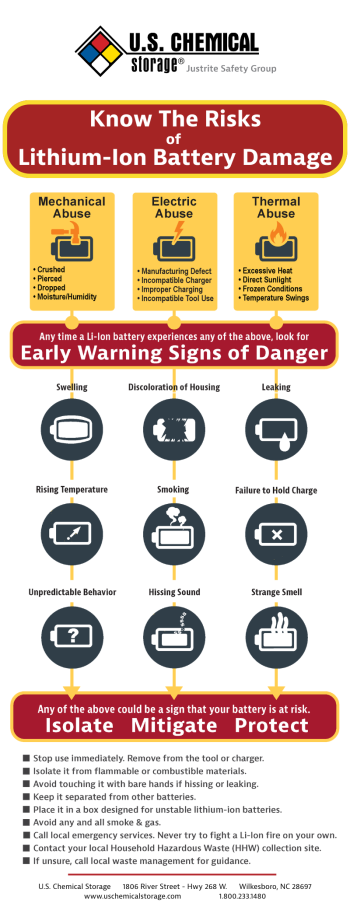Storing Lithium-Ion Batteries: Best Practices & Regulations
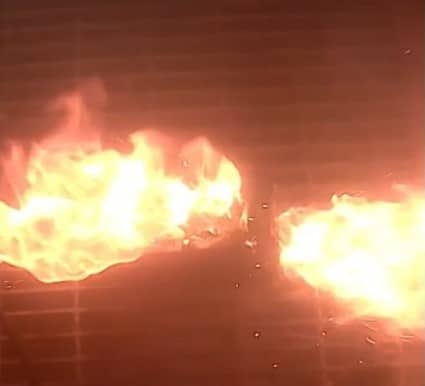
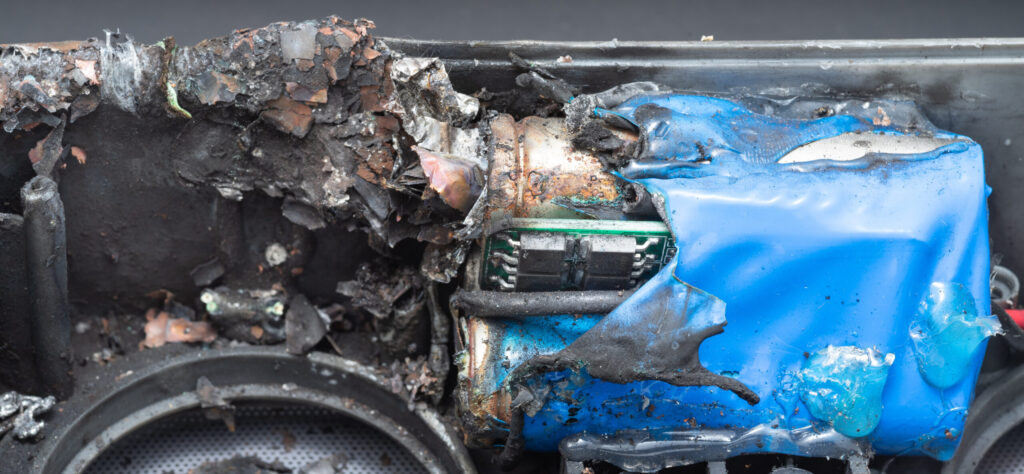
Since their introduction in 1991, lithium-ion (Li-ion) batteries remain popular among small and large corporations alike due to their long lifespans and lightweight designs. Lithium-ion batteries are rechargeable batteries that reverse Li+ ions into electronically conducting solids for greater specific energy, density, efficiency, and lifecycle than other types of rechargeable batteries.
Today, with their greater density yet lesser cost, we use lithium-ion batteries as the main power source for smartphones, laptops, tablets, medical devices, power tools, drones, scooters, bikes, and electric cars. However, if lithium batteries are not stored properly with the right compliance and handling, they not only have less longevity but can also become extremely dangerous. In this article, we’ll offer some suggestions on how to accomplish safe storage of lithium batteries.
Understanding Lithium-Ion Battery Storage Risks
It is important to know that incorrect lithium battery storage can present possible risks due to the physical and chemical properties of lithium batteries themselves, as well as environmental properties. The below infographic addresses many of the mechanical, electric, and thermal causes of failure in lithium batteries. (click to open up in a new window for download)
Lithium Battery Fire Risks
Because of a propensity to self–heat, properly storing lithium batteries is necessary to avoid fires that can harm you and your property. When the lithium battery temperature is -20 to 5°C and there is an incoming charge current over 10 amps, self-heating can occur. The result can be the release of gas, which can cause fires, and even explosions.
Furthermore, if you store groups of these batteries together in a space, one battery or cell overheating can set off a chain reaction to the other neighboring bodies, where greater overheating, melting, smoking, fire, gas, and explosions (thermal runaway) are the result. Battery misuse or internal short circuit defects from manufacturing, improper charging, dropping, puncturing, damaging, or exposing the battery to liquids and excessive temperatures can also create thermal runaway, which can be hard to extinguish once started.
Chemical Exposure Risks
If you happen to store lithium-ion batteries in an attached garage of your home, for instance, said gases you’re exposed to could be a threat to your health. Chemical exposure creates flammability, toxicity, corrosivity, and reactivity hazards. A common way that you can come into contact with lithium-ion batteries’ contents is when their electrolytes (a combination of solvents with an electrolytic salt) leak as either liquid or gas.
If the electrolyte leaks and either reacts with moisture or ignites, acidic substances emit. Toxic substances from these batteries like chromium, lead, CO, and thallium, cause many discomforting side effects, such as nausea, vomiting, and abdominal pains, and even more dangerous side effects, such as muscle weakness, shortness of breath, seizures, and coma.

Best Practices for Storing Lithium-Ion Batteries
To avoid risks, it is advised to follow some common best practices for proper storage of lithium-ion batteries based on temperature, location, and maintenance protocols.
Ideal Temperature & Charge Levels
Temperature is vital for understanding how to store lithium batteries. The recommended temperature for lithium-ion battery storage for most varieties would be ideally 15°C (59°F), a moderate area that isn’t extremely hot nor extremely cold–but that’s not the case across the board. So, before storing lithium batteries, thoroughly read labels on proper temperature for your specific battery type. Placing your batteries in a temperature-controlled room would ensure safe regulation. Lithium battery storage buildings with climate control are ideal for storing bulk quantities of Li-ion batteries at specific temperatures to ensure a safe storage environment.
Also, be aware of the state of charge while storing. Nickel and lithium-ion batteries should be stored at around 40% state of charge. Lithium-ion batteries might become unstable if not stored at their proper levels. Be sure to know the specifics unique to YOUR battery. To ignore such information could prove devastating. Overcharging may cause excessive heat to damage the battery internally and potentially create a fire event. Some batteries specify a charge between 30% and 50%. Some cells can be stored fully discharged, although the cell voltage should not drop below 2.0 for optimal safety. The maximum voltage should not exceed 4.1 volts.
Always follow the individual charging instructions provided with each Li-ion battery from the manufacturer.
Storage Conditions & Locations
The storage requirements for lithium-ion batteries are a mix of the right ventilation, humidity level, and indoor versus outdoor location regulation. Lithium-ion batteries should be stored in cool, moderately dry conditions away from direct sunlight, heat/flame-encouraging materials, and humid elements. For those reasons, generally, it is encouraged to store your battery indoors where temperatures and conditions can be controlled to prevent extremes.
Typically, lithium-ion batteries should be in a space that doesn’t have a humidity level over 50%. However, if the humidity is too low, the lack of moisture can cause rusting, which can short-circuit the battery and lead to fire.
Use a desiccant when storing your battery, along with having the right ventilation system that is proofed against explosion and hydrogen accumulation but promotes good air circulation. When storing your lithium-ion batteries outside, do so in a shaded area, away from direct sunlight, to help extend battery life and prevent overheating.
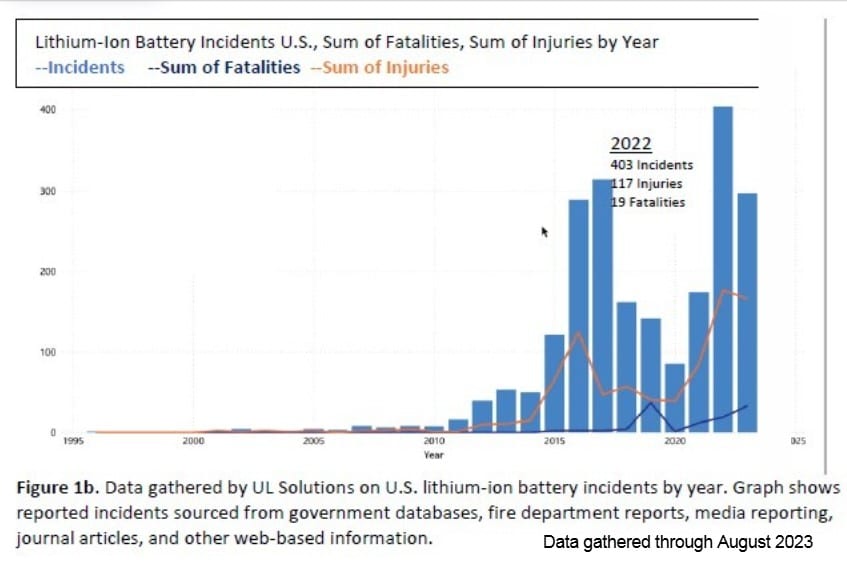
Additional Considerations When Using Lithium-Ion Batteries
- Inspect your lithium-ion batteries before storing them.
- Avoid impact on your batteries.
- Monitor battery charge status while on charger.
- Ensure that the charging environment is climate controlled.
- Observe run time with a fully-charged battery.
- Keep battery unplugged from the tool it powers when storing it long-term.
- If a battery is dropped, inspect it closely for damage and isolate if possible until tested.
- Check batteries before placing them in storage for any irregularities in appearance or charge status.
- Avoid exposing Li-Ion batteries to excessive vibration.
- Do not keep batteries in excessively high OR low temperatures.
- Always handle batteries with caution.
- Store Li-Ion batteries in the storage building only after it reaches recommended ideal temperature.
- Do not use damaged batteries.
- In case of contact with battery fuid, do not rub. Immediately flush with water.
- Try to wash hands after handling batteries.
- You should periodically monitor and recharge lithium-ion batteries in storage to compensate for natural self-discharge (usually 10-20% per year).
What To Do With Lithium-Ion Batteries at End-of-Life
After lithium-ion batteries are completely nonfunctional, proper handling still needs to take place. According to the US Environmental Protection Agency (US EPA), old lithium-ion batteries should be transported to trash or recycle facilities separately from household waste should not go in household garbage or recycling bins. They can cause fires during transport or at landfills and recyclers.
Instead, Li-ion batteries should be temporarily stored in a separated separate plastic bin (not metal) and then taken to separate recycling or household hazardous waste collection point indicated by your municipality or local authority. Those locations are the only ones known to have the resources to safely manage them without causing a fire hazard. Find some suitable locations through: call2recycle.org
Compliant Storage Solutions for Lithium-ion Batteries
Since temperature is a vital factor in ensuring your batteries are stored safely, US Chemical Storage offers climate control options for your battery storage building, including access controls and temperature regulation to keep your operation running smoothly.
Fire suppression systems are a must for storing hazardous materials, which is why we offer several options for fire suppression, including dry chemical storage fire suppression or water sprinklers to possibly slow a fire event. Our buildings also feature mechanical ventilation, fiberglass grated flooring, and a variety of door styles for exit and entry. These factors are designed with the user in mind for the safe movement of lithium-ion batteries.
Your solution should be a 2 or 4-hour fire-rated building that meets and exceeds EPA, OSHA, and NFPA regulatory compliance.
Being able to access your materials when and where you need them is crucial to smooth, productive operation.
Location is another critical aspect of storing batteries long-term. U.S. Chemical Storage provides safe, reliable, prefabricated storage buildings, including solutions for outdoor and indoor storage.
Fire-rated lithium storage buildings can be located outdoors and placed a safe distance away from other property if necessary. This can also allow fire fighters to surround the building and isolate the fire should one occur.
Lastly, you can keep your high-capacity lithium-ion batteries (EVs, energy storage systems, industrial use) easily sectioned off and isolated with multi-room storage options.

Regulatory Considerations for Lithium Battery Storage: NFPA and OSHA Considerations
Until very recently, there was no code in the U.S. that regulated the proper storage of new or used batteries, charging of batteries, or the recycling of batteries. Regulatory bodies had difficulty understanding the risks, and agreeing to the best way to fight them should an incident occur. However, in 2024 some major progress has been made.
NFPA 855: Standard for the Installation of Stationary Energy Storage Systems (2023)
This regulation is a bit of a misnomer to many who think “Stationary Energy Storage System” only applies to Energy Storage Systems (ESS). The most recent update of the 2023 edition updated the standard purpose saying it “provides the minimum requirements for mitigating the hazards associated with ESS and the storage of lithium metal or lithium-ion batteries.”
US Chemical Storage’s fire-rated storage buildings are designed in alignment with NFPA’s Chapter 14 sector in the 855 standard based on thorough collection, location, and explosion-proof safety elements followed in our construction.
UL, DOT, and FM Approvals for Battery Storage Buildings
There are several other independent standards for proper lithium battery storage/BESS systems, but three UL standards are the most widely accepted for safe renewable energy, battery, and thermal runaway matters:
- UL 1973: Batteries for Use in Stationary and Motive Auxiliary Power Applications
- UL 9540: Energy Storage Systems and Equipment
- UL 9540A: Test Method for Evaluating Thermal Runaway Fire Propagation in Battery Energy Storage Systems
The Department of Transportation (DOT) 38.3 regulation enforces guidelines around shipping and transferring of lithium-ion cells and batteries via tests that must be passed before commutation. The FM Global code DS 7-112 provides loss prevention guidance for liquid lithium-ion battery manufacturing and storage.
International vs. U.S. Regulations
On the other hand, international regulations might address installing emergency or standby power systems installation requirements (like the International Building Code (IBC) Chapter 27 Section 2702.1.3) but not signage requirements (International Code Council). A national standard can help fill in those gaps, like the NFPA 855 standard Section 4.3.5, which guides signage requirements.
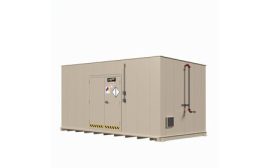
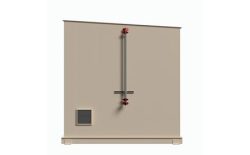

ISOLATE
MITIGATE
PREVENT
We design lithium battery buildings for highly dangerous flammable and combustible chemicals and hazmat every day. Regulatory bodies and committees are in constant meetings, revisions, and publishing phases to catch up to the risks that are growing every day. U.S. Chemical Storage is committed to staying involved and educated on high-level code surrounding lithium-ion batteries as regulations and standards roll out across the county.
Finding Safe Lithium-Ion Battery Storage with U.S. Chemical Storage
Upholding Safety and Quality
Li-ion batteries present challenges and hazards to manufacturers who rely on safely storing these powerful energy tools, and the right storage solution can make or break your operation. U.S. Chemical Storage prides itself on providing safe and reliable prefabricated storage buildings designed to store lithium batteries. Carefully designed lithium battery storage buildings present a tangible solution for how to store or charge batteries while preserving your products for ease of access and battery safety.
For instance, our 2- or 4-hour fire-rated design storage can be customized to include further safety features like water sprinkler fire suppression systems to limit the spread of fires.
RELATED ARTICLE: Lithium-Ion Battery Safety Takes the Spotlight at FDIC 2025
Serving Across Industries
U.S. Chemical Storage is happy to service several industries that depend on lithium-ion batteries and Li-ion cells for production, including automotive, marine, medical, robotics, aerospace, tech, and the semiconductor industry. However, the list is growing exponentially every day. We proudly work with the military for mission-critical applications and have a reputation for providing safe products suited for drones, surveillance, UAVs, and other vital equipment.
Have questions about how we can serve your industry, store your lithium batteries, and deliver engineered custom and compliant lithium battery storage solutions to help you ISOLATE, MITIGATE, and PREVENT a lithium battery event?
Ensure safe lithium-ion battery storage with our fire-rated, climate-controlled storage solutions. Get a quote today!

